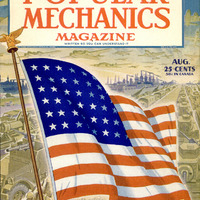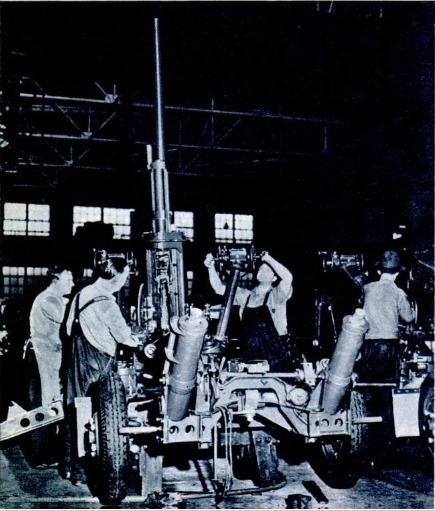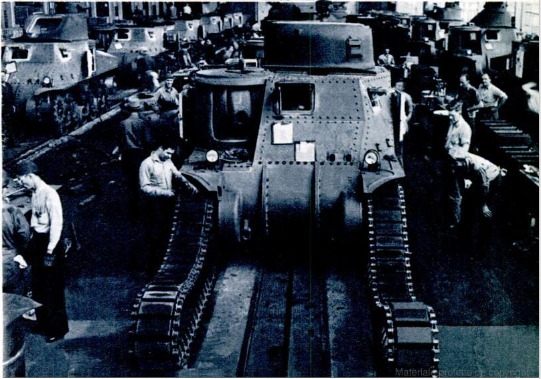THE German bomber that had just crashed in flames near an English city appeared to be one of the conventional types, even though the force of the crash and the heat of the fire had made it a misshapen mass. Hardly had the tangled wreckage cooled before technical experts were swarming over it o extract its secrets. Aviation engineers searched for new instruments and equipment; combustion engineers checked over what was left of its motors; mechanical engineers looked for evidences of new structural ideas. There was also a metallurgist among the experts. As he combed over the wreckage, he picked up bits and chunks of metal, labeled their location and apparent use as best he could, and took them away for examination. In his laboratory he carefully scrutinized the specimens, determined their composition by chemical analysis and by the spectrograph, examined them under a metallurgical microscope, tested them for hardness, strength and elasticity. Most of the specimens were familiar, either through previous examination of German planes or because they were standard metals and alloys used almost universally in airplane construction. One specimen was puzzling, however. It was a small piece of steel which the tests showed contained a small percentage of a rare metal sometimes used as an alloying element with certain nonferrous metals, but not generally alloyed with steel. The presence of the rare element in the steel was probably accidental, but it might have been purposeful. The Germans might have developed a new and useful alloy steel. To determine the facts, metallurgists in both England and the United States were set to work. What they learned cannot be disclosed for military reasons. Analysis of the metals in captured war equipment is routine in modern warfare. The purpose is not only to discover whether new and better alloy steels are being used, but also to learn whether the enemy is running short of valuable alloying elements and having to rely on leaner alloys or even plain carbon steels. This war is primarily a war in which one side pits its steel in the form of planes, ships, tanks and guns against the steel produced by the other side. The outcome will depend partly upon the quality of the steel available to the victor, as well as the quantity. The United States and our allies are fortunate in that they can make considerably more than twice as much steel as all the axis and axis-dominated countries of the world together. The United States alone can produce three tons of steel for every two tons that can be made in Germany, Italy and Japan and all of conquered Europe. In quantity, we lead the world by a wide margin. In quality, too, we are supreme. If there is any such thing as a “mystery weapon” in this war, it is the great family of alloy steels the American steel industry is producing in record-breaking tonnages for the specialized needs of war. Some are new; others were developed for peacetime purposes but have been adopted for military use. Plain carbon steels will probably always remain the basic material of construction in both peace and war. When extra strength, hardness, or corrosion resistance is needed, however, elements such as nickel, chromium or molybdenum are added to carbon steel. The result is an alloy steel. By adding as little as one-half of one percent of molybdenum, for example, steel is made more resistant to heat. A little chromium makes steel harder; more chromium makes steel corrosion resistant. Nickel makes steel tough. Each of those alloy steels, and many others besides, have specific uses in modern war equipment. Already the alloy steels in American-made fighting equipment have passed the severe test of combat service. The first test came with the torpedoing of the destroyer Kearny nearly two months before Pearl Harbor. The Kearny is a bigger ship than most older destroyers, but she is at least as fast and maneuverable as her predecessors. Unlike the destroyers of World War I, the Kearny has two sets of boilers and two engines - one forward and one aft. Explosion of the torpedo crippled the forward boiler and engine, but she was able to make port with her aft engine. The fact that the Kearny is a big destroyer is only one reason why she could be equipped with the second engine and boiler. Of almost equal importance is the fact that the naval architects could employ in her power plant alloy steels not available in the last war. The boiler tubes and turbines of the Kearny were made of alloy steels so much stronger than ordinary steels that her engines could be made proportionately lighter than those in older destroyers. Thus the Kearny could be powered with two engines rather than one, at no sacrifice of speed. The turbine shafts of the Kearny were forged from an alloy steel approximately twice as strong as those used in 1920. Boiler tubing has similarly been improved so that per pound of weight it is far stronger than formerly and can function at higher temperatures and pressures. Originally the steels used in the Kearny’s power plants were developed for the nation’s power and light companies. The operating economies resulting from the utilities’ use of these steels have been an important factor in cutting in two since 1920 the price the consumer pays for electricity. In wartime, these same alloy steels have helped increase the speed and operating range of our navy, reduced fuel consumption, and, in the case of the Kearny, helped keep a naval vessel afloat. In the air, too, American alloy steels have been showing their ability to absorb punishment. Perhaps the outstanding performance of American planes has been given by the huge Flying Fortress bombers. Used in the attack on Japanese ships in the western Pacific, those bombers have time and time again struck heavy blows without the protection of fighter planes. No bomber can fly higher than the Fortress planes, and few enemy planes can intercept them at their maximum height of over five miles. Such high-altitude flying would be impossible without a supercharger to increase the supply of air to the engine. Flying five miles high, a 1,000-horsepower motor not so equipped would deliver less than half its rated power. Superchargers are operated by the hot, corrosive gases exhausted from the plane’s engines. Alloy steels make it possible to harness the blast. Modern bombers use tons of other alloy steels in vital parts. One grade of steel is extensively used in tubing, much like a bird’s hollow bones. It forms, in effect, the feet, neck and strongest wing bones of the modern plane. This alloy steel has twice the strength of the best tubing available 20 years ago. Used in the landing gear or “feet,” it is better able to withstand the shock of emergency landings. In the “neck” of the plane, alloy steel tubing securely anchors the heavy high-powered engine to the frame. Wings and fuselage are strengthened in key places by alloy steel tubing and forgings. Alloy steels comprise most of the engine’s weight. The strength and durability of such steels have greatly increased the reliability of the engine. Exhaust valves, for example, stand up under temperatures of 1,600 degrees Fahrenheit and help make possible sustained speeds of over 400 miles an hour. In fighting on land, the value of high-quality alloy steels has been enormous. Military observers report that American light tanks in Libya showed great speed and durability and on numerous occasions outfought heavier tanks. A tank is not designed to operate on smooth concrete highways, and the conditions under which it does operate impose terrific strains, particularly upon its track. If a single link in the track is broken, whether by antitank shell or by a metallurgical defect, the tank is immobilized. The tracks of American tanks have proved highly reliable. Alloy steels are used in key parts, one steel used being the same type that in peacetime was used for heavy truck axles. In almost all kinds of mechanical military equipment, whether tanks, jeeps or gun carriers, dead weight is reduced to a minimum so that higher speeds may be reached or heavier guns and armor carried. Here again, alloy steels have a big role. Alloy steels make possible such reductions in weight because, being stronger, they permit the use of thinner and lighter sections in structural and moving parts. The armed forces are finding the high-tensile, low-alloy steels especially useful for this purpose. Those steels contain only small quantities of alloys, but they have substantially better physical properties than ordinary steel. One grade used in mechanized military equipment was originally developed for railroad cars and trucks. America’s capacity to produce steels of all kinds has already been a factor in certain theaters of the war. The full weight of its superiority over the enemy countries, however, has not yet made itself felt. During 1941 and even in the early months of this year, a large proportion of our steel capacity was still needed for uses “behind the lines.” New factories had to be built and tooled up; shipways, training camps and defense housing projects had to be erected. In the enemy countries, this phase of preparing for actual fighting was completed years ago. As 1942 progresses, however, the proportion of our steel output that can be used against the enemy in combat equipment will steadily increase. Rigid conservation will be necessary in the use of alloying elements, many of which must be imported, to assure maximum production of military and naval equipment. So urgent is the demand for alloy steels in war, and so necessary is it to conserve our supplies of the alloying elements, that many alloy steels are for the moment unavailable for civilian needs. When victory is won, however, there will be available for civilian use not only those steels which have already contributed so much to our material progress, but new steels besides. They will all be used to raise still further the American standard of living.
 Popular Mechanics, vol. 78, n. 2, 1942
Popular Mechanics, vol. 78, n. 2, 1942





